Accumulation Of Heavy Metal Lead (Pb) And Cadmium (Cd) In Halophila ovalis And Thalassia hemprichii As Agents Of Phytoremediation In South Serangan
on
Journal of Marine and Aquatic Sciences 6(2), 161-168 (2020)
Accumulation Of Heavy Metal Lead (Pb) And Cadmium (Cd) In Halophila ovalis And Thalassia hemprichii As Agents Of Phytoremediation In South Serangan
I Ketut Budiarta a*, Elok Faiqoh a, I Gusti Ngurah Putra Dirgayusa a
a Department of Marine Science, Faculty of Marine and Fisheries, Udayana University, Jimbaran, Badung, Bali-Indonesia
* Correspondent author. Tel.: +62-857-926-76415
E-mail address: budhiartha11@yahoo.co.id
Diterima (received) 2 Oktober 2018; disetujui (accepted) 2 Desember 2020; tersedia secara online (available online) 2 Desember 2020
Abstrak
Ekosistem padang lamun merupakan salah satu bagian dari ekosistem perairan yang memiliki peranan cukup penting secara ekologi. Halophila ovalis dan Thalassia hemprichii merupakan spesies lamun yang memiliki potensi sebagai agen fotoremediasi dengan mengetahui konsentrasi akumulasi logam berat Pb dan Cd pada lamun. Penelitian ini dilakukan pada bulan Januari 2018 di pantai Selatan Serangan dengan tujuan untuk mengetahui konsentrasi logam berat pada air, sedimen, akar dan daun lamun serta mengetahui bioakumulasi, sifat translokasi logam berat sehingga dapat dijadikan sebagai agen untuk fitoremediasi. Metode yang dilakukan adalah metode metode purposive random sampling, ditentukan sebanyak 3 stasiun. Stasiun ditentukan dari kondisi terdekat dengan pelabuhan Benoa hingga titik terluar mulut teluk. Penentuan titik stasiun ditentukan dengan mempertimbangkan keberadaan lamun terbanyak. Hasil yang didapat pada penelitian ini diperoleh konsentrasi Pb pada air rata-rata 0,0521 ppm, logam Cd rata-rata 0,1652 ppm , pada sedimen rata-rata Pb 75,8574 ppm, Cd 15,3593 ppm, konsentrasi Pb dan Cd pada akar dan daun lamun Halophila ovalis dan Thalassia hemprichii berturut turut logam Pb 42,4940 ppm, 45,5334 ppm, dan 35,6207 ppm, 38,3931 ppm., Untuk logam Cd 12,9708 ppm 14,8581 ppm. Nilai bioakumulasi kedua jenis lamun >1, tanaman akumulator. Nilai faktor translokasi logam Pb dan Cd pada lamun Halophila ovalis >1(fitoekstraksi). Pada lamun Thalassia hemprichii Pb >1 (fitoekstraksi) dan Cd <1 (fitostabilisasi). Nilai fitoremediasi diperoleh kedua jenis lamun lebih besar meremediasi logam berat kadmium, artinya kedua jenis lamun baik digunakan untuk agen fitoremediasi logam berat kadmium.
Kata Kunci: akumulasi; logam; berat; lamun; Serangan
Abstract
Seagrass ecosystem is part of the marine ecosystem that has quite important ecological role. Halophila ovalis and Thalassia hemprichii are seagrass species have the potential to become an agent of phytoremediation by determining the concentration of heavy metals Pb and Cd that have accumulated in them. This study was conducted in January 2018 in Southern Serangan Beach. The purpose of investigating the concentration of heavy metals in water, sediments, roots and leaves of seagrass and determine the bioaccumulation, translocation character and can be made as an agent for phytoremediation. The method used is purposive random sampling method, determined by 3 point. The point is determined from the condition closest to the port Benoa to the outermost point the bay mouth. Determination of station points is considering the presence of the most seagrasses. Results obtained in this study obtained average Pb concentration in water 0.0521 ppm, average metal Cd 0.1652 ppm, the average sediment Pb 75.8574 ppm, Cd 15.33593 ppm, concentration of Pb and Cd in roots and leaves of H. ovalis and T. hemprichii respectively Pb 42.4940 ppm, 45.5334 ppm, and 35.6207 ppm, 38.3931 ppm. Metal Cd 12.9708 ppm 14.8581 ppm Bioaccumulation value of seagrass is accumulator plants. Value of Pb and Cd translocation factors in seagrass H. ovalis (phyto-extraction) seagrass T. hemprichii Pb (phyto-extraction) and Cd (fitostabilization) phytoremediation values by both types of seagrass are greater in remediating heavy metal cadmium, meaning that both types of seagrass are better used for phytoremediation agents of heavy metal cadmium.
Keywords:: accumulation; heavy; metal; seagrass; Serangan
Pollution is something that has become a problem for in our daily lives, and gives a harmful effect on the ecosystem. One of the more dangerous pollutants are heavy metals. Heavy metals in aquatic ecosystems can accumulate in plants through biomagnification and absorption, and accumulate in sediment by process deposition. (Mulyani et al., 2012).
Serangan Island located in the east Benoa Bay. Serangan Island are home to coral reefs, mangroves and seagrasses. The seagrass ecosystem are found on the north, east, and south coasts of the island (Martha et al., 2019). Due to its geographic proximity to the port, the seagrass ecosystem off South Serangan are can potentially be affected by the pollution from port activities. The waters off the Southern Coast of Serangan are also the pathways for tidal circulation in Benoa Bay and a sea lane for boats coming in to Benoa Pir (Al Tanto et al., 2017). This tidal circulation can potentially carry pollutants from the pier through South Serangan waters.
Heavy metals have properties that make them difficult to be degraded, making it possible to accumulate in biota (Mulyani et al., 2012). According to data from the Ministry of Environment and Forestry (2015), the potential burden of pesticide pollution from agricultural activities are 100.27 liters/year. This could potentially be a source of heavy metal pollution in the region.
The Seagrass ecosystem is a part of the marine ecosystem that has quite an important ecological role. The role of seagrass ecosystems among other things are, stabilizing aquatic sediments (Jahnke et al., 2016), and is a feeding ground and provides food for some marine biota (Kendrick et al., 2012) and Seagrass also have a function as an association place for as Echinodermata animal (Vindia et al., 2016). Some research on the benefits of seagrass as an accumulator of heavy metals have previously been conducted. Study of heavy metal accumulation of Pb and Cd in Enhalus acoroides in the Tanjung Lanjut Waters Pb heavy metals ranged from 0.1088 mg / L - 0.1915 mg / L and heavy metal Cd ranged from 0.3907 mg / L - 0.4536 mg / L (Pratiwi et al., 2014). According to research by Laharjana (2016), a species composition of H. ovalis has grown about 16.20% in the southern region of
Serangan. In addition, Halophila ovalis and Thalassia hemprichii are food for sea turtles and dugongs (Nontji in Juraij et al., 2014). And according Ermavitalini and Noviarini (2015), a concentration of 0.1 ppm cadmium can cause damage el root
It is therefore necessary to study the ability of H. ovalis and T. hemprichii in accumulating and remediating heavy metals Pb and Cd. The purpose of this study was to determine the content and accumulation of heavy metals Pb and Cd in the roots and leaves of H. ovalis and T. hemprichii found in South Serangan Beach and analyze its translocation and phytoremedation of heavy metals Pb and Cd from roots to leaves.
Serangan Island is a small island with an area of 412 Ha after reclamation, so that the entire territory has coastal characteristics. Serangan Island is at the mouth of the east side of Benoa Bay. This research was conducted in January 2018, which took place in South Serangan Beach, Denpasar, Bali. The observation location is divided into three observation points based on the presence of seagrasses in the South of Serangan (waters of the southern part of the Serangan island), Bali.
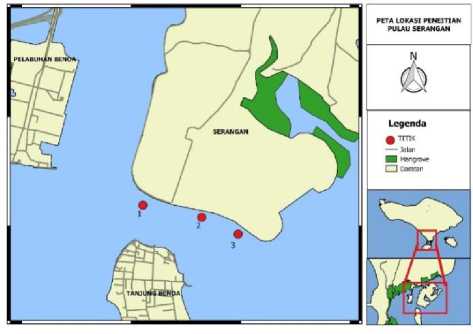
Figure 1. Map Research location in south Serangan Bali Indonesia.
-
2.2 Tools and Materials
The tools used in this study include : Cooling box, plastic, PVC Core 30x5 cm, Plastic bottles, measuring pipettes , beaker glass, Analytical scales, ICPE-9000, filter paper, oven, aluminum foil. The materials used were distilled water, Seawater,
Sediment, HNO3, H2SO4, and the roots and leaves of Halophila ovalis and Thalassia hemprichii.
-
2.3 Sampling Method
The point area using purposive random sampling method, determined as many as 3 point. The point is the condition closest to the port of Benoa to the outermost point of the bay mouth. Determination of points is determined by considering the presence of the most seagrasses.
-
2.3.1. Seagrass Sampling Methods
Samples are taken once at each point. As much as 110 stirring seagrasses are taken for each repetition. Seagrass samples are collected during low tide conditions and are taken at the roots and leaves of seagrass. Samples of seagrass are then washed using freshwater to remove any sediment, epiphytes, and fauna, and are separated between the roots and the leaves. Samples of roots and leaves of seagrass that have been cleaned are stored in plastic bags and then put into the cool box for analysis in the laboratory.
-
2.3.2. Water Sampling
Sea water samples are collected in 500 ml plastic bottles directly around the seagrass. The sea water will then be added with 2 ml of concentrated HNO3, in order to preserve the samples. After that, the sea water samples are put in a cool box for analysis in the laboratory.
-
2.3.3. Sediment Sampling
Sediment samples are collected from seagrass substrate. Sediment samples are taken as much as ± 75 mg at a depth of 5-15 cm, then put in plastic bags and stored in a cool box.
-
2.4 Heavy Metal Content Analysis
-
2.4.1. Analysis of Heavy Metals in Water.
-
It is done by inserting a 1 ml sample of sea water in a glass beaker and diluting it using 25 ml of distilled water, then testing the samples for heavy metal levels using an ICP Spectrometer (ICPE-9000).
-
2.4.2. Analysis of Heavy Metals in Sediment.
Collected sediment samples are dried in an oven. Sample analysis are carried out after drying. The
samples are taken in 0.5 grams parts and dissolved using 10 ml of H2SO4 until it becomes a thick black color, then it is added with 10 ml of HNO3. The mixture is then diluted in distilled water until its volume reaches 100 ml. Then the samples are tested using the ICPE-9000).
-
2.4.3. Analysis of Heavy Metals on Roots and Leaves Halophila ovalis and Thalassia hemprichii
The cleaned washed seagrass packed in aluminum foil paper and then dried using a 70˚C oven for 24 hours. The dried roots and seagrass leaves of H. ovalis and T. hemprichii were taken as much as 0.5 grams of dry weight for each sample of leaves and roots of seagrass. Extraction was carried out by homogenizing the sample by adding 10 mL of concentrated H2SO4. After a thick black color, 10 ml of HNO3 is added. After that the sample was transferred to a measuring flask of 50.0 mL and added with distilled water to a volume of 100 ml. Next the sample was filtered using filter paper with a pore size of 0.45μm. The concentration of heavy metals in sea water, sediment and seagrasses was analyzed using Inductively Coupled Plasma Emission (ICPE) 9000 Spectroscopy (detection limit 0.001).
-
2.5 Analysis method
-
2.5.1. Descritive
-
Heavy metal in water and sediment were analyzed descriptively in the form of diagrams and Tables in accordance with the quality standards for heavy metals lead (Pb) and Cadmium (Cd) in sea water, according to the Decree of the Minister of Environment No. 51 Year 2004 regarding Standard Seawater and quality standard of heavy metal content in sediment by IADC / CEDA (1997).
-
2.5.2. BCF (Bioaccumulation Concetration Factor)
Bioacumulation (BCF) analysis was conducted to determine the level of accumulation of heavy metals Pb and Cd in the roots and leaves seagrass H. ovalis and T. hemprichii. Bioaccumulation factors calculated by the following formula (Connell in Sugiyanto et al., 2016).
BCF= Kb (PPm)
Cw( ppm) (1)
Bcf is Bioaccumulation factor; Kb is heavy metal conten in biota; and Cw is heavy metal content in sediment. The plants were divided into 2 categories. That is accumulators if the value of BCF >1; and excluder: if the BCF value <1
-
2.5.3. TF (Translocation Factor)
Translocation (TF) analysis is used to calculate the process of translocation of heavy metals Pb and Cd from roots to leaves.
IF = leaf ( PPm ) root (ppm )
(2)
TF calculation used by (Amriarni et al., 2011) using a formula that is. TF value according to have 2 categories. If TF> 1 that is Phytoextraction mechanisms; and if TF <1 that is Phytostabilitation mechanisms
-
2.5.4. FTD (Phytoremediation)
Phytoremediation according to Hamzah and Pancawati, (2013) is one of economic solution to reduce pollutant. Phytoremediation is the difference between the BCF with TF.
FTD = BCF - TF (3)
Phytoremediation would be maximized if the BCF high and low TF (Liong et al., 2009). Phytoremediation analysis is to compare the great value of phytoremediation of heavy metals lead and cadmium in two of seagrasses, H. ovalis and T. hemprichii.
The concentration of lead metals in sea water averaged 0.0521 ppm, while the concentration of cadmium metal with an average of 0.1652 ppm (Figure 2). In sediment samples are different from the conditions in sea water. Heavy metal con heavy metals cadmium. The average concentration of lead in sediment is 75.8574 ppm while heavy metal cadmium with an average of 15.3593 ppm (Figure 3).
Heavy metal concentrations of Pb and Cd in seawater on the southern coast of Serangan are higher when compared to the quality standards that have been set by the Decree of Minister of
Environment No. 51 of 2004 on the Quality Standard of Sea Water. High concentration of heavy metal pollution in these area is assumed cause by port activities and input from several river that running off to Benoa Bay. South coast area of Serangan Island is the closest area to Benoa harbor, which is a highly active port.
In general, the waste containing lead from waste industrial paint, ship painting, battery and fuel (Pratiwi et al., 2014). The use of cadmium compounds in life such as the manufacture tube TV, paint, rubber, soap, fireworks, textile printing and pigments for glass (Sarjono in Oktaria, 2015). Increasing the concentration of heavy metals in the waters will disrupt the food chain cycle and will affect the biota in it (Said et al., 2009). According Febriana (2017), heavy metal Pb and Cd can damage the chloroplast, which will reduce chlorophyll content on phytoplankton. Phytoplankton in ecosystems play an important role as primary productivity at the sea (Simanjuntak, 2009).

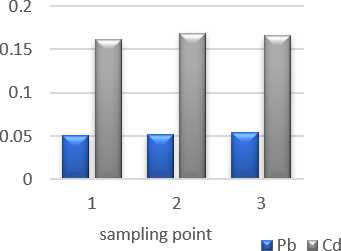
Figure 2. Pb and cd content in sea water
From the analysis results of 6 points on the substrate seagrass sediment sampling South Coast Offensive obtained results that exceeded the quality standard of heavy metals in sediment, according to the IADC / CEDA (1997). Heavy metal lead is at target level is the substance present in the sediments is not too dangerous for the environment. While for the concentrations of heavy metals cadmium is at the level of intervensi which is categorized as medium contaminated. Supriyantini and Endrawati (2015), which states that the content of heavy metals in the sediments are much higher than in the water column, it is because the heavy metals into the water column will be absorbed by particles suspended. It showed the accumulation of heavy metals in sediments from sea water were suspended.
Results of research done by Siaka (2008), the correlation depth in Benoa Harbor and concentrations of Pb and Cu, Pb obtained for heavy metals in the surface with a concentration of 15.52 ppm depth 10 cm 13.49 ppm and at 20 cm dept 11.51 ppm. When compared with the results obtained for the research on the South coast Serangan to a depth of 0-15 cm sediment concentration greater is an average of 75.85 ppm
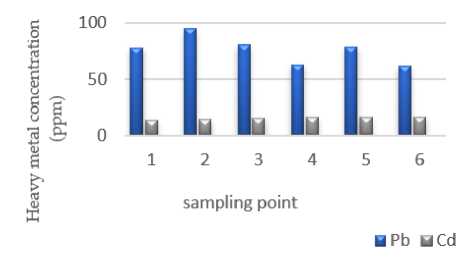
Figure 3. Pb and cd content in sediment
-
3.2 Heavy Metal Pb and Cd on Seagrasses
Concentration of heavy metals in H. ovalis and T. hemprichii in South Beach Serangan contains heavy metals Pb and Cd is higher than quality standard of heavy metals in biota with the concentration of lead metals in both roots and leaves in both types of seagrasses was higher when compared with the concentration of heavy metals of cadmium H. ovalis lead at the roots averaged 42.4940 ppm, leaves 45.5334 ppm cadmium in roots and in leaves 12. 9708 ppm and leaves 14.8581 ppm. T. hemprichii lead at an average root of 35.6207 ppm, leaves 38.3931 ppm cadmium in roots and leaves at 13.22 ppm and leaves 11.0511 ppm. (Figure 4 and 5).
H Pb root
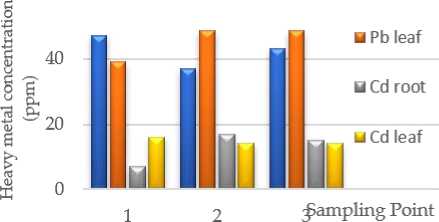
Figure 4. Pb and cd content in H. ovalis
Concentration of heavy metals contained in the second high enough above seagrass species that is
H. ovalis and T. hemprichii, shows that these seagrass can accumulate the metal compound (nonessential) not use by plants. If compared with the concentration of heavy metals in water, the concentration of heavy metals contained in a concentration greater seagrass. These results are consistent according Pratiwi et al (2014), explained that seagrass more accumulate heavy metals Pb and Cd than seawater. In both types of seagrass H. ovalis and T. hemprichii, has a greater concentration of the heavy metals lead (Pb) when compared with the heavy metal cadmium (Cd). Heavy metal concentrations higher lead allegedly due to the nature of lead metal tends to precipitate and bind to the particles suspended sediments and then the sediment will be absorbed by the roots of seagrass (Rochyatun et al., 2010). High concentration of heavy metals in seagrass allegedly caused by the absorption of heavy metals along with nutrients not only in roots but also in leaves albeit in smaller amounts than in the roots.
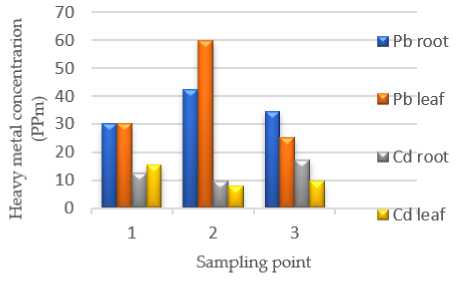
Figure 5. Pb and cd content T. hemprichii
The concentration of heavy metals lead and cadmium are quite high on H. ovalis seagrass species and T. hemprichii in South Beach Serangan, potentially also impact the level trophic level of biota. Some types of seagrass known as a favorite food for turtles and dugongs (Juraij et al, 2014). Seagrass H. ovalis and T. hemprichii role as the food of turtles and dugongs. So if H. ovalis seagrass species and T. hemprichii in South Beach Serangan eaten by turtles and dugongs, the two organisms are potentially contaminated by heavy metals lead and cadmium.
-
3.3 Bioaccumulation of Heavy Metal
Bioaccumulation analysis is used to determine the value of the concentration of transporting heavy metal pollutants to the seagrass plant. From the
results of bioaccumulation analysis of heavy metals lead and cadmium in seagrass species H. ovalis obtained the following values. Bioaccumulation of heavy metal lead has a value of> 1, which means that the plant is an accumulator which is a good plant in absorbing heavy metals Lead into its body tissues. Bioaccumulation Cadmium heavy metals bioaccumulation value> 1 means that seagrass H. ovalis is also an accumulator. In T. hemprichii seagrass, bioaccumulation of heavy metals lead and cadmium in this seagrass type has a value of> 1, which means that T. hempriichii seagrass plants have accumulator properties which are good plants in absorbing heavy metal pollutants lead and cadmium into the body tissues.
In seagrass species H. ovalis and T. hemprichii have the ability to accumulate cadmium metal higher than that of lead heavy metals. This result is in accordance with the research conducted by Sugiyanto et al. (2016), on E. acoroides seagrass with bioaccumulation value on Pb heavy metals in seagrass roots and leaves is 1.44 and 1.76 while the average bioaccumulation of Cd in the roots and seagrass leaves is 3.77 and 4.48. Higher cadmium concentrations are in accordance with Palar in Istarani (2014), statement which states that the Cadmium ion has high bioaccumulation characteristics in the body of organisms and plant.
Table 1
Bioacumulation of Pb and Cd in seagrass
|
Heavy Metal |
Pb (ppm) |
Cd (ppm) |
|
Type of seagrass | ||
|
H. ovalis |
1.0549 |
1.9309 |
|
T. hemprichii |
1.0774 |
1.4843 |
-
3.4 Translocation Factor
Translocation tactor is used to calculate the process of transalocation of heavy metals of lead and cadmium in seagrass species H. ovalis and T. hemprichii. In seagrass H. ovalis translocation value for heavy metals lead and cadmium> 1. Translocation value> 1 means the mechanism of localization of phyto-extraction (Table 2).
The mechanism of phyto-extraction is the process of absorbing heavy metals by the roots of plants which are then translocated towards the
stem/leaf. This means that seagrass H. ovalis is able to translate heavy metals lead and cadmium from the roots towards the leaves. T. hemprichii seagrass has translocation value for lead heavy metal> 1 and cadmium <1 heavy metal means that seagrass of T. hemprichii is able to tether heavy lead metal from root to leaf, but for heavy metal translocation cadmium can only be absorbed in most sediments / substrates stored in the root or called phytostabilization mechanism.
Table 2
Translocation of Pb and Cd in seagrass
|
Heavy Metal |
Pb (ppm) |
Cd (ppm) |
|
Type of seagrass | ||
|
H. ovalis |
1.0371 |
1.3718 |
|
T. hemprichii |
1.0488 |
0.8707 |
-
3.5 Phytoremediation
Phytoremediation is the absorption of pollutants mediated by plants including trees, grasses, and aquatic plants. Phytoremediation analysis was carried out to determine the large ratio of concentrations of heavy metals lead and cadmium which can be mediated by seagrass plants H. ovalis and T. hemprichii on the south coast of Serangan.
Seagrass type H. ovalis the phytoremediation value of lead (Pb) was 0.0118 and cadmium (Cd) of 0.5590. This means that H. ovalis seagrass is larger in remediation of cadmium heavy metals compared to lead heavy metals. It can be interpreted that seagrass H. ovalis can be used for the purpose of phytoremediation of heavy metal cadmium in water. For the type of seagrass T. hemprichii, the concentration of Pb heavy metals was also smaller than that of Cd, namely Pb 0.0286 ppm and Cd 0.6136 ppm. This means that T. hemprichii seagrass can also be used as a phytoremediation of heavy metal cadmium in the waters.
Table 3
Phytoremediation at Seagrass
|
Heavy Metal Type of seagrass |
Pb (ppm) |
Cd (ppm) |
|
H. ovalis |
0.0178 |
0.5590 |
|
T. hemprichii |
0.0286 |
0.6136 |
The results of these two types of seagrass were lower when compared to the study (Sugiyanto et al., 2016) on seagrass type E. acoroides on roots and leaves with heavy metal values of Cd (3.00 ppm and 4.11 ppm) and heavy metals Pb (0.08 ppm and 0.48 ppm). Phytoremediation value will be maximized if the heavy metal bioaccumulation value is higher than the factor translocation value (Sugiyanto et al., 2016). The concentration of Cd heavy metals in sediments which is lower than Pb concentration is thought to be that these aquatic plants are good at remediati ng Cd heavy metals compared Pb.
From the results of the study can be concluded as follows: the concentration of heavy metals Pb and Cd contained in the water of Pb concentration in water on average 0.0521 ppm, metal Cd on average 0.1652 ppm, on sediments in sediments on average Pb 75.8574 ppm, Cd 15, 3593 ppm, Pb and Cd concentrations in roots and seagrass leaves Halophila ovalis and Thalassia hemprichii respectively Pb 42.4940 ppm, 45.5334 ppm, and 35.6207 ppm, 38.3931 ppm, and for metal Cd 12.9708 ppm 14.8581 ppm and 13.222 ppm, 11.05117 ppm.
The bioaccumulation value of both seagrass species obtained values >1 (accumulator) which is a good plant in absorbing heavy metal lead and cadmium pollutants. The value of Pb and seagrass metal translocation factors H. ovalis >1 (phytoextraction) means that heavy metals are translocated to the stem / leaf, in T. hemprichii Pb >1 (phytoextraction) and Cd <1 (phytostabilization) Cd metal is mostly stored in the root. Phytoremediation values obtained by both types of seagrass are greater in remediating heavy metal cadmium, meaning that both types of seagrass are better used for phytoremediation agents of heavy metal cadmium.
Acknowledgements
The authors thank God Almighty, thanks to the grace of this study can be completed on time. Not forgetting also thanks to friends Weda, Ika, Dedi, Panji, Gita, Ayu, Anasita who have strongly helped in the process of sampling in the field. The authors also thank to both reviewer.
References
Al Tanto, T., Wisha, U. J., Kusumah, G., Pranowo, W. S., Husrin, S., Ilham, I., & Putra, A. (2017). Karakteristik
Arus Laut Perairan Teluk Benoa–Bali. Geomatika, 23(1), 37-48.
Amriarni, A., Hendrarto, B., & Hadiyarto, A. (2011). Bioakumulasi logam berat timbal (Pb) dan seng (Zn) pada kerang darah (Anadara granosa L.) dan kerang bakau (Polymesoda bengalensis L.) di Perairan Teluk Kendari. Jurnal Ilmu Lingkungan, 9(2), 45-50.
Ermavitalini, D., & Noviarini, W. (2015). Analisa
Kerusakan Jaringan Akar Lamun Thalassia Hemprichii yang Terpapar Logam Berat Kadmium (Cd). Jurnal Sains dan Seni ITS, 4(2), E71-E71
Febriana, H. A., Purnomo, P. W., & Suryanti, S. (2017). Kadar Logam Berat Pb, Cd Dan Kelimpahan Perifiton Pada Ekosistem Lamun Di Pantai Barat Bandengan Jepara. Buletin Oseanografi Marina, 5(2), 107-114.
Hamzah, F., & Pancawati, Y. (2013). Fitoremidiasi Logam Berat dengan Menggunakan Mangrove
(Phytoremiditation of Heavy Metals Using Mangroves). Ilmu Kelautan, 18(4), 203-212.
Istarani, F. F., & Pandebesie, E. S. (2014). Studi dampak arsen (As) dan kadmium (Cd) terhadap penurunan kualitas lingkungan. Jurnal Teknik ITS, 3(1), D53-D58.
IADC / CEDA. (1997). International Association of Dredging Companies, and the Central Dredging Association. 1997. Environmental aspects of dredging - conventions, codes and conditions: marine disposal. International Association of Dredging Companies (IADC), and the Central Dredging Association (CEDA), Netherlands, 1-71. www.iadc-dredging.com/.../nr66.pdf
Jahnke, M., Christensen, A., Micu, D., Milchakova, N., Sezgin, M., Todorova, V., & Procaccini, G. (2016). Patterns and mechanisms of dispersal in a keystone seagrass species. Marine environmental research, 117, 5462.
Juraij, J., Bengen, D. G., & Kawaroe, M. (2014).
Keanekaragaman Jenis Lamun Sebagai Sumber Pakan Dugong Dugon Pada Desa Busung Bintan Utara Kepulauan Riau. Omni-Akuatika, 10(2), 71-76
Kendrick, G. A., Waycott, M., Carruthers, T. J.,
Cambridge, M. L., Hovey, R., Krauss, S. L., ... & Ooi, J. L. (2012). The central role of dispersal in the maintenance and persistence of seagrass populations. BioScience, 62(1), 56-65.
KLH. (2004). Keputusan Menteri Negara Lingkungan Hidup Nomor 51 Tahun 2004. Tentang Baku Mutu Air Laut. Jakarta-Indonesia: Menteri Negara Lingkungan
Hidup.
Laharjana, A. K. (2016). Asosiasi moluska benthik dengan lamun di Perairan Pulau Serangan Bali. Skripsi.
Denpasar, Bali: Program Study Ilmu Kelautan,
Fakultas Kelautan Dan Perikanan Universitas
Udayana.
Liong, S., Noor, A., Taba, P., & Zubair, H. (2009).
Dinamika akumulasi kadmium pada tanaman kangkung darat (Ipomoae reptans Poir). Indonesia Chimica Acta, 2(1), 39-45.
Martha, L. G. M. R., Julyantoro, P. G. S., & Sari, A. H. W. (2019). Kondisi dan Keanekaragaman Jenis Lamun di Perairan Pulau Serangan, Provinsi Bali. Journal of Marine and Aquatic Sciences, 5(1), 131-141.
Mulyani, S., & Triani, I. G. A. L., Nurdiansyah, A. S. E. (2012). Identifikasi cemaran logam Pb dan Cd pada kangkung yang ditanam di Daerah Kota Denpasar. Jurnal Bumi Lestari, 12(2), 345-349.
Oktaria, N., Hanifah, T. A., & Anita, S. (2014). Analisis kandungan logam merkuri, kadmium, timbal dan sianida pada aliran Sungai Indragiri, Kabupaten Indragiri Hulu. Jurnal Online Mahasiswa Fakultas Matematika dan Ilmu Pengetahuan Alam Universitas Riau, 2(2), 83-90.
Pemprov Bali. (2015). Laporan Status Lingkungan Hidup Daerah Provinsi Bali Tahun 2015. Buku Laporan. Bali, Indonesia: Pemerintah Provinsi Bali
Pratiwi, A. R., Willian, N., & Pratomo, A. (2014). Analisis Kandungan Logam Berat (Pb) dan (Cd) Terhadap Lamun (Enhalus Acoroides) Sebagai Bioindikator Di Perairan Tanjung Lanjut Kota Tanjungpinang. Jurnal Zarah, 2(1).
Rochyatun, E., Kaisupy, M. T., & Rozak, A. (2010). Distribusi logam berat dalam air dan sedimen di perairan muara Sungai Cisadane. Makara Journal of Science, 10 (1), 35-40.
Said, I., Jalaluddin, M. N., Upe, A., & Wahab, A. W. (2009). Penetapan konsentrasi logam berat krom dan timbal dalam sedimen estuaria Sungai Matangpondo Palu. Jurnal Chemica, 10(2), 40-47.
Siaka, I. M. (2008). Korelasi antara kedalaman sedimen di Pelabuhan Benoa dan konsentrasi logam berat Pb dan Cu. Jurnal Kimia, 2(2), 61-70.
Simanjuntak, M. (2009). Hubungan faktor lingkungan kimia, fisika terhadap distribusi plankton di perairan Belitung Timur, Bangka Belitung. Jurnal Perikanan Universitas Gadjah Mada, 11(1), 31-45.
Sugiyanto, R. A. N., Yona, D., & Kasitowati, R. D. (2016). Analisis akumulasi logam berat timbal (Pb) dan kadmium (Cd) pada lamun Enhalus Acoroides sebagai agen fitoremediasi di Pantai Paciran, Lamongan. In Seminar Nasional Perikanan dan Kelautan VI. Universitas Brawijaya Malang, Indonesia, April 2016 (pp.449-455).
Supriyantini, E., & Endrawati, H. (2015). Kandungan Logam Berat Besi (Fe) Pada Air, Sedimen, Dan Kerang Hijau (Perna viridis) Di Perairan Tanjung Emas Semarang. Jurnal Kelautan Tropis, 18(1), 38–45.
Vindia, W. I., Julyantoro, P. G. S., & Wulandari, E. (2019). Asosiasi Echinodermata pada Ekosistem Padang Lamun di Pantai Samuh, Nusa Dua, Bali. Journal of Marine and Aquatic Sciences, 5(1), 100-108.
© 2020 by the authors; licensee Udayana University, Indonesia. This article is an open access article distributed under the terms and conditions of the Creative Commons Attribution license (http://creativecommons.org/licenses/by/3.0/).
J. Mar. Aquat. Sci. 6: 161-168 (2020)
Discussion and feedback